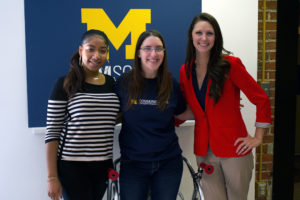I’m no stranger when it comes to social media. In my youth, I was active on MySpace, Xanga blog, and AIM. My social media presence today comprises Facebook, Pinterest, LinkedIn, and Twitter but I don’t have an Instagram or Snapchat account. Why not? I never saw a need to have those prior to being an intern at UMSocial.
Let me first reintroduce myself. I’m Melissa Barber, a freelance web and graphic designer. I’ve been freelancing since graduating from Bowling Green State University seven years ago. Freelancing is sometimes a challenge for me. I love working in my PJs, being my own boss, and setting my own schedule, but I missed the face-to-face interaction and teamwork you experience in an office. I love the team-based atmosphere—I thrive off it! So I was excited to learn about the internship opportunity at UMSocial. I had been looking for a steady job apart from freelancing—and then I heard about the Bridge to Work Program through my MRS counselor. Bridge to Work offers individuals with disabilities job placements at the University of Michigan. You can read more about the program here.
Why am I mentioning this program? I have mild cerebral palsy (CP), which was caused at birth when I had a lack of oxygen to my brain. Because of my CP, I have physical limitations along with a speech impairment, which sometimes makes freelancing difficult for me. I’ve come to realize and accept that some people don’t want to take the time to understand someone with a disability. That’s why I’m glad the Bridge to Work Program was established.
I was graciously given 12 weeks at UMSocial and another 12 weeks at Michigan Creative. I not only wanted this internship to be informative for me and help move my career forward, I also wanted it to serve as a teaching aid for accessibility in social media. I believe that U-M is leading the way on how people interact through their various social media accounts, but the institution also needs to consider how accessible their content really is.
Did you know that one in five individuals in the U.S. has a disability? That translates to about 19 percent of the population, according to 2010 statistics from the Census Bureau. That’s 19 percent of the prospective audience that is missing out on content because it isn’t accessible for them to read or digest. That 19 percent may not seem like a large number, but why limit access to 81 percent of the population when it’s possible to reach 100 percent?
Imagine not understanding what someone is saying in a video, or not knowing what or who was in a picture posted by your friend. Imagine continually misinterpreting posts or tweets because of difficulty accessing content. These are daily issues that individuals with disabilities face when engaging with others via social media. I don’t want to speak for all disabled individuals because I’m just one person with only a physical limitation, but I have friends who are legally blind and hearing impaired and I see their struggles firsthand. I helped produce a short video demonstrating some helpful tips that can make any content you post accessible. I encourage you to watch it here.
I believe that social media only works when it’s accessible to everyone. By “accessible,” I mean making videos with captions, adding Facebook and Twitter image captions to photos, using “camel case” hashtags in Twitter posts, and so on. Producing accessible content isn’t that difficult; it only takes a few minutes to make posts accessible.
I’m passionate about social media accessibility and want to be an advocate for others with disabilities. During my two-part internship at U-M, I not only got to bring what I’m passionate about to the table, but I was able to learn a lot too. When it came to interning at UMSocial, I thought I was a social media pro, but I was wrong! I soon discovered that social media is much more than posting about your day or retweeting an article you found interesting. At UMSocial, there’s a lot going on behind the scenes that our audience does not realize. There are strategic planning and analytics involved in every post, video, and tweet.
As a web and graphic designer, I got to witness firsthand the strategic planning side when I created my first Father’s Day campaign. I’m a daddy’s girl at heart, so I thought it would be fun to get pictures of U-M students and/or staff with their dads to use in a collage for a Father’s Day graphic. I didn’t quite realize how much planning goes into everything UMSocial puts out. First, you need to decide what you want to accomplish with the campaign. Then comes strategic planning, and then creating GIFs and graphics. All in all, it was a fun campaign to do and received a fair amount of reactions and likes on Facebook, Instagram, and Twitter.
This was also my first time creating animated GIFs. In college, we were taught how to create animations in Flash but not in Photoshop or Adobe After Effects. It was a whole new experience for me and I loved learning new techniques. I received good tips and tricks from another UMSocial graphic designer. I had a lot of fun making holiday GIFs for UMSocial and I improved with every piece of content I created.
Everybody at UMSocial and Michigan Creative was so encouraging and helpful throughout my 24 weeks here. I’m going to miss everyone in the office. It has been a privilege to be a part of the creative, collaborative team that is UMSocial and Michigan Creative. I hope I’ve inspired and taught them as much as they have me.
As always, #BeSocial and #StaySocial. I’ll see you all on the flipside!
By: Melissa Barber





